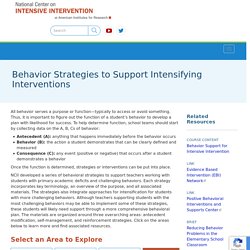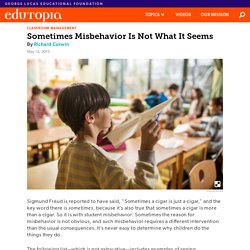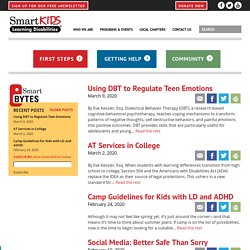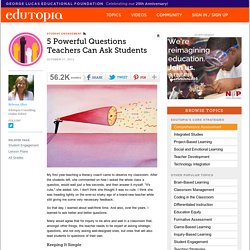

How To Weave Growth Mindset Into School Culture. Adilene Rodriguez admits she has always struggled with academics.

Especially in middle school she hated getting up early, found her classes boring and didn’t really see where it was all going. IEP Goal Bank. Articulation Goals: Long Term Goal: Student will produce the // speech sound with 90% mastery.

Short Term Objectives: 1. Behavior Strategies to Support Intensifying Interventions. All behavior serves a purpose or function—typically to access or avoid something.

Thus, it is important to figure out the function of a student’s behavior to develop a plan with likelihood for success. To help determine function, school teams should start by collecting data on the A, B, Cs of behavior: Antecedent (A): anything that happens immediately before the behavior occurs Behavior (B): the action a student demonstrates that can be clearly defined and measured Consequence (C): any event (positive or negative) that occurs after a student demonstrates a behavior Once the function is determined, strategies or interventions can be put into place. The Four Keys to Helping At-Risk Kids. There's more than one way to make a delicious bread, soup, or stew. Similarly, there is not just one recipe for reducing risk in students' lives. But there do seem to be some essential ingredients to the process. Drawing from recent studies on the topic, I've come up with four basic ingredients that seem to match well with the stories and observations people have shared with me based on earlier blog posts I have written.
How Ending Behavior Rewards Helped One School Focus on Student Motivation and Character. Valleroy decided to change the school’s culture in 2007, after she and other educators on her staff attended conferences on character education, including events hosted by Leadership Academy in Character Education at the University of Missouri-St. Louis. Inspired by what she’d learned, especially about the corrosive effect of rewards, she returned to Northview and launched a character education committee and school leadership team. Valleroy knew she needed staff buy-in, and over a period of years sent educators to conferences on character. Together, they revamped lesson plans to incorporate character development into all aspects of the curriculum, and shared the new plans on the school intranet.
She also worked with the staff to craft a new mission statement for the school that put character at the center. Some teachers struggled at first with the removal of extrinsic rewards. Instead of handing out prizes, teachers tried to reach children by talking about what’s inside them. Sometimes Misbehavior Is Not What It Seems. Sigmund Freud is reported to have said, “Sometimes a cigar is just a cigar,” and the key word there is sometimes, because it’s also true that sometimes a cigar is more than a cigar.

So it is with student misbehavior: Sometimes the reason for misbehavior is not obvious, and such misbehavior requires a different intervention than the usual consequences. Missouri Department of Elementary and Secondary Education. Organizing Tips for Children with ADHD: Helping Disorganized Students. The problem: The child forgets to bring the right books and supplies home or to school.

His disorganized school supplies — desk, locker, backpack, and notebook — are in disarray. He forgets deadlines and scheduled activities. The reason: The neurological process that lets us organize, prioritize, and analyze is called “executive function.” Children with ADHD and related neurobiological problems experience executive dysfunction due to abnormal dopamine levels in the frontal lobe of the brain. The obstacles: Punishment will not change disorganized behaviors that are related to brain pathology, only strategies for disorganized students will. ADHD Organizing Tips for the Classroom Children who take ADHD medication may show some improvement in their ability to stay organized; however, they still need teachers and parents to provide support and teach them essential life skills.
—Provide additional supplies. Make Learning Awesome! Anxiety at School - Accommodations to Help your Anxious Child. Smart Kids. By Eve Kessler, Esq.

Dialectical Behavior Therapy (DBT), a research-based cognitive-behavioral psychotherapy, teaches coping mechanisms to transform patterns of negative thoughts, self-destructive behaviors, and painful emotions into positive outcomes. DBT provides skills that are particularly useful for adolescents and young… Read the rest. Reality 101: CEC's blog for new special education teachers. As our kindergarten team was leaving a meeting the other day the reading specialist added one more comment, “Let’s change how we are talking about our reading groups,” she suggested, “ Instead of referring to our groups as the reading level they are currently reading, let’s call them by the goal reading level we set for them.”

There was silence for a minute as we let that idea sink in. It is so simple, and yet, so wise. A Day in the Life of a Special Education Teacher - Mrs. D's Corner. 5 Powerful Questions Teachers Can Ask Students. My first year teaching a literacy coach came to observe my classroom.

After the students left, she commented on how I asked the whole class a question, would wait just a few seconds, and then answer it myself. "It's cute," she added. Um, I don't think she thought it was so cute.